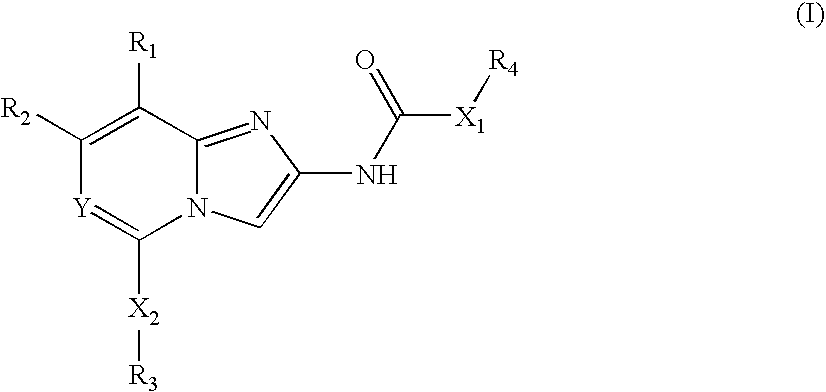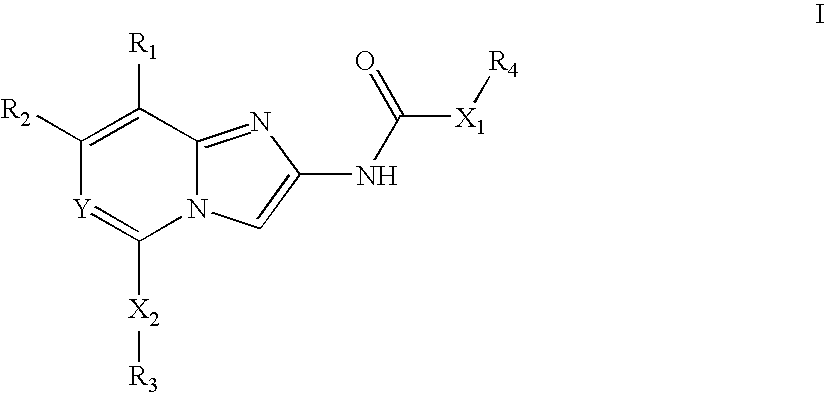Antibacterial agents
- Summary
- Abstract
- Description
- Claims
- Application Information
AI Technical Summary
Benefits of technology
Problems solved by technology
Method used
Image
Examples
example 1
Preparation of (7-Pyridin-3-yl-imidazo[1,2-a]pyridin-2-yl)-carbamic acid ethyl ester and 1-Ethyl-3-(7-pyridin-3-yl-imidazo[1,2-a]pyridin-2-yl)-urea
[0220]
Step 1: Preparation of [3,4′]Bipyridinyl-2′-ylamine
[0221] 2N Na2CO3 (20 mL, 0.04 mol) was added to a suspension of aminopyridine (1) (1.00 g, 5.78 mmol) and boronic acid (2) (1.06 g, 8.67 mmol) in toluene (60 mL) and the mixture was purged with nitrogen gas. Bis(diphenylphosphino)ferrocenepalladium(II) chloride, dichloromethane complex [hereinafter “PdCl2(dppf)”] (0.17 g, 0.21 mmol) was added and the mixture was refluxed under nitrogen for 1.5 hours. Ethyl acetate was added and the solution was washed with water, dried over Na2SO4 and adsorbed onto silica by removal of solvent in vacuo. The residue was chromatographed on silica, eluting with MeOH / EtOAc (1:15) to give product (3) as a powder (0.87 g, 87%). APCI-MS found: [M+H]+=172.
Step 2: Preparation of (7-Pyridin-3-yl-imidazo[1,2-a]pyridin-2-yl)-carbamic acid ethyl ester (Exam...
examples 2-4
[0224] Using the general procedure of Example I, but substituting the relevant starting material, the following compounds were prepared:
2A) [7-(2-Dimethylamino-pyrimidin-5-yl)-imidazo[1,2-a]pyridin-2-yl]-carbamic acid ethyl ester
[0225]
[0226] as a solid, mp 270-280° C. (decomposed). 1H NMR (400 MHz, DMSO-D6) δ ppm 10.14 (br, 1H), 8.82 (s, 2H), 8.54 (d, J=7.0 Hz, 1H), 7.82 (br s, 1H), 7.68 (d, J=1.8 Hz, 1H), 7.21 (dd, J=7.0, 1.8 Hz, 1H), 4.16 (q, J=7.1 Hz, 2H), 3.18 (s, 6H), 1.25 (t, J=7.1 Hz, 3H).
2B) 1-[7-(2-Dimethylamino-pyrimidin-5-yl)-imidazo[1,2-a]pyridin-2-yl]-3-ethyl-urea
[0227]
[0228] as a solid, mp 259-263° C. (decomposed). 1H NMR (400 MHz, DMSO-D6) δ ppm 8.84 (br s, 1H), 8.81 (s, 2H), 8.50 (d, J=7.1 Hz, 1H), 7.71 (s, 1H), 7.65 (d, J=1.8 Hz, 1H), 7.18 (dd, J=7.1, 1.8 Hz, 1H), 6.70 (br, 1H), 3.18 (s, 6H), 3.16 (dq, J=7.1, 5.4 Hz, 2H), 1.08 (t, J=7.1 Hz, 3H).
3A) [7-(6-Methoxy-pyridin-3-yl)-imidazo[1,2-a]pyridin-2-yl]-carbamic acid ethyl ester
[0229]
[0230] as a solid, mp 273-...
example 5
Preparation of (7-Pyridin-3-yl-imidazo[1,2-c]pyrimidin-2-yl)-carbamic acid ethyl esters
[0235]
Step 1: Preparation of 6-Amino-4-chloropyrimidine (1)
[0236] 4,6-Dichloropyrimidine (10.0 g, 67.1 mmol) in ammonia saturated ethanol (40 mL) was heated to 100° C. in a stainless steel pressure vessel for 1.5 h. Removal of the solvent in vacuo gave a solid which was triturated with water (270 mL) then filtered to give 6-amino-4-chloropyrimidine (1) (6.18 g, 71%) as white crystals. APCI-MS Found [M+H]+=130, 132.
Step 2: Preparation of (7-Chloro-imidazo[1,2-c]pyrimidin-2-yl)-carbamic acid ethyl ester (2)
[0237] A solution of 6-amino-4-chloropyrimidine (1) (0.504 g, 3.89 mmol) and N-chloroacetylurethane (0.770 g, 4.65 mmol) in 1,3-dimethyl-2-inimidazolidinone (10 mL) was heated to 130° C. under nitrogen for 3 h. N-Chloroacetylurethane (0.770 g, 4.65 mmol) was added and the mixture was heated to 130° C. under nitrogen for a further 3.5 h. The black oily solution was poured onto ice (200 g) and...
PUM
| Property | Measurement | Unit |
|---|---|---|
| Density | aaaaa | aaaaa |
| Density | aaaaa | aaaaa |
Abstract
Description
Claims
Application Information
 Login to View More
Login to View More - R&D
- Intellectual Property
- Life Sciences
- Materials
- Tech Scout
- Unparalleled Data Quality
- Higher Quality Content
- 60% Fewer Hallucinations
Browse by: Latest US Patents, China's latest patents, Technical Efficacy Thesaurus, Application Domain, Technology Topic, Popular Technical Reports.
© 2025 PatSnap. All rights reserved.Legal|Privacy policy|Modern Slavery Act Transparency Statement|Sitemap|About US| Contact US: help@patsnap.com



